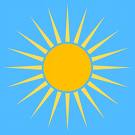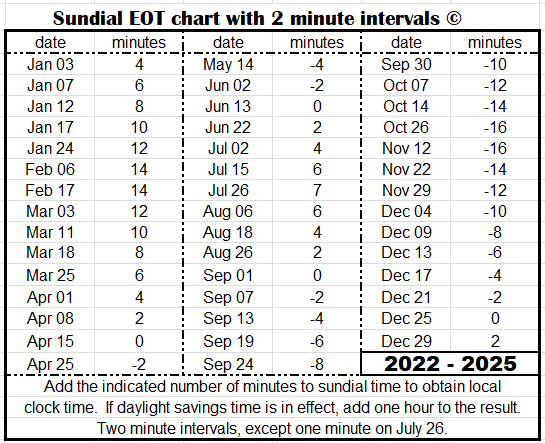| [-] How to convert from sundial time to clock time: |
| (a) If it's daylight savings time (from the second Sunday in March to the first Sunday in November), add an hour to the sundial time. |
| (b1) Determine your latitude and longitude. To do that, use a GPS device, or in Google maps, right click on your location, click on "What's here?", and your latitude and longitude will appear. For the Ingleside Terraces (IT) Sundial, they are 37.725 and -122.47 degrees. |
(b2) The middle of the time zones (clock time) are spaced at 15 degree intervals, i.e. 0 (GMT), -15, -30...-105, -120 (PST and PDT). IT is 2.47 degrees west of the middle of our time zone, so our suntime is 60x2.47/15, approximately ten minutes earlier than our clock time, so ten minutes must be added to the sundial time. |
| (c1) A correction must be made for the "equation of time" (EOT). The earth does not travel around the sun at a constant speed. When the earth is near perihelion (closest to the sun, around January 3), the speed of the earth's revolution around the sun increases (Kepler's second law, a line joining a planet and the Sun sweeps equal areas of space during equal time intervals as the planet orbits), solar noon appears later each day, and up to 15 minutes needs to be added to the sundial time to obtain clock time. After aphelion (farthest from the sun, around July 4), up to 15 minutes needs to be subtracted to the sundial time to obtain clock time [eccentricity correction]. The earth rotates 361 degrees per 24 hours, and every year the equation of time correction repeats itself.
(c2) Around the equinoxes, March 21 and September 21, as the sun crosses the equator, suntime gets faster compared to clock time [obliquity correction]. |
 |
| (d) The diameter of the sun as seen from the earth is about 0.5 degrees. As there are 15 degrees longitude per hour, this means that the shadow from the west side of the sun is about two minutes earlier than the shadow from the east side of the sun. This limits sundial accuracy to about a minute or two. The Ingleside Terraces sundial can be read within a minute or two, so having a longer gnomon or larger dial would not improve the accuracy of a sundial. |
| (e) From September 27 to October 2 and from December 1 to December 5 in Ingleside Terraces, the corrections for longitude and for the equation of time cancel each other, although in September and October one hour must still be added to sundial time to obtain daylight savings time. |
| (f) "Leap seconds" were not used until 1972, and since that time there have been 27 leap seconds. They are not taken into account in the equation of time. This may gradually make clock time slower than sundial time over a period of many years. |








